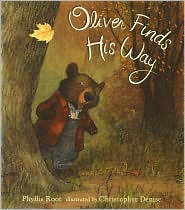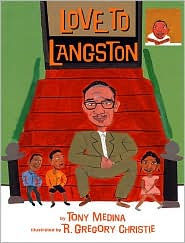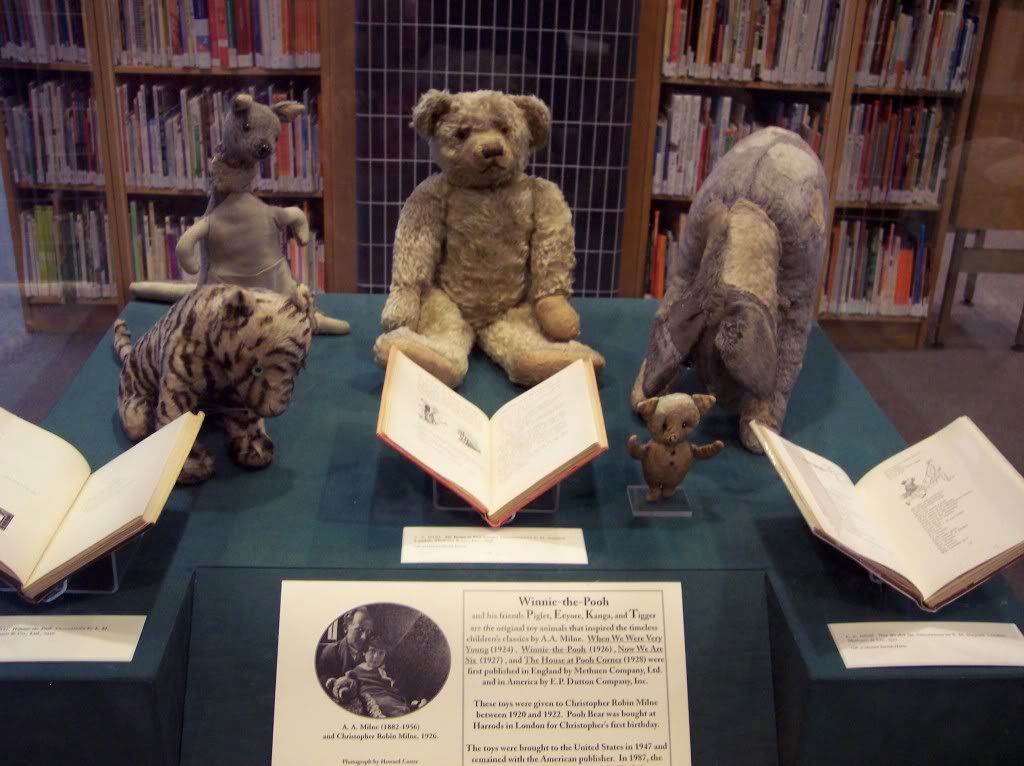 OLIVER FINDS HIS WAY
OLIVER FINDS HIS WAY
Written by Phyllis Root
Illustrated by Christopher DeniseCandlewick Press, 2002 is an exceptional picture book for students in preschool and kindergarten. Phyllis Root’s simple storyline about a little bear who finds himself lost near the edge of the woods, panics, and then thinks of a way to solve his problem, will resonate with young children. Christopher Denise’s illustrations, done in pastels and charcoal, provide a soft autumnal backdrop for Root’s spare text. They capture the flavor of the season and closeness of this loving “bear” family.
One fall day, while his parents are doing chores outside, Oliver chases an autumn leaf that is blown by the wind. He follows the big yellow leaf…
down the hill,
around a clumpy bush,
under a tree,
and all the way
to the end of the woods.Soon enough, Oliver discovers that he is lost. He tries to find his way back home--but the tree he runs to is not the twisty one he had passed before and the bush he runs to is not the clumpy bush he had seen earlier. Oliver’s afraid. He begins to cry…and cry….and cry. But he soon realizes that he’s still lost. He rubs his nose and thinks until he gets an idea. Then he roars and roars and roars--louder and
louder and
louder--until he hears Mama and Papa roaring back. Oliver is then able to listen to their roars and find his way home.
Note: When I was an elementary librarian, I used the art in
Oliver Finds His Way to introduce my youngest students to the concept of setting in picture books. The children could tell just from looking at the endpapers that the story was set out in the country in autumn. Click
here to view an illustration from the book.

FLETCHER AND THE FALLING LEAVES
Written by Julia Rawlinson
Illustrated by Tiphanie Beeke
Greenwillow, 2006
It’s autumn. Fletcher, a young fox, notices that the world around him is changing. Every morning things seem “just a little bit different.”
The rich green of the forest was turning to a dusty gold, and the soft, swishing
sound of summer was fading to a crinkly whisper.
Fletcher becomes worried when his favorite tree begins to look dry and brown. He thinks the tree is sick and expresses concern to his mother. His mother explains that it’s “only autumn” and not to worry. Fletcher runs outside, pats his tree, and tells it that it will feel better soon.
Of course, the leaves on the tree continue to turn brown and fall from the branches. Fletcher catches a falling leaf and reattaches it to his tree--but the wind shakes the leaf loose again.
The next day, a strong wind blows through the forest, and the tree’s leaves are set flying. Fletcher’s upset when he sees a squirrel taking leaves for its nest and a porcupine using the fallen leaves to keep itself warm. Try as he might, Fletcher cannot save his tree from the inevitable. Finally, he clutches the last leaf as it flutters from the tree and takes it home--where he tucks it into a little bed of its own.
The following morning, Fletcher is awed by the sight of his tree, which is now hung with thousands of icicles shimmering in the early morning light. He wonders, though, if the tree is okay and asks: “But are you all right?” Fletcher is relieved when a breeze shivers the branches and the tree makes “a sound like laughter…” The little fox then hugs his tree and returns to his den for a “nice, warm breakfast.”
Fletcher and the Falling Leaves has a longer, more lyrical text than Oliver Finds His Way. Beeke’s soft-edged pastel illustrations capture the tone and setting of this comforting story and deftly convey the change of seasons as autumn turns to winter.

THE LITTLE YELLOW LEAF
Written & illustrated by Carin Berger
Greenwillow, 2008
Carin Berger, who did the “bold” and brilliant collage illustrations for Jack Prelutsky’s Behold the Bold Umbrellaphant, hits a high note again with her art in The Little Yellow Leaf. Her illustrations in this book are inventive and striking. Berger even used composition and graph paper as the backdrop for some of her pictures. Her spare illustrations with changing perspectives and her lovely lyrical text partner well in this tale about finding strength in friendship.
The main character of this little allegory is a “Little Yellow Leaf.” It’s autumn. The LYL clings to a branch of “a great oak tree.” “I’m not ready yet, thought the Little Yellow Leaf as a riot of fiery leaves chased and swirled round the tree.” No, the leaf isn’t ready to leave its home in the tree--even as the afternoon sun beckons--even…
as apples grew musky,
pumpkins heavy,
and flocks of geese
took wing.
Even when LYL sees that the other leaves have “gathered into heaps, crackly dry, where children played,” it isn’t willing to join them. And it still it isn’t ready to leave its home when a harvest moon blooms in an “amber” sky.
LYL holds fast to its branch through a long, cold night when snow falls. It holds fast as days pass. It looks and looks at the tree--but sees only the “shimmer of snow.” LYL is all alone. At least that’s what it thinks…until one day it spies a “scarlet flash” high up in the tree. It has a comrade! Both had been hesitant to cast off for the unknown. The Little Yellow Leaf and the Scarlet Leaf take courage in each other…set themselves free and soar.
Into the waiting wind they danced…
off and away and away and away.
Together.
I highly recommend these three titles, which will make fine autumn read-alouds.
I love the poetry of Langston Hughes. I used to read poems from his book The Dream Keeper to my second grade students. I always shared poems from the book when I read them Coming Home: from the Life of Langston Hughes, a picture book biography that was written and illustrated by Floyd Cooper.


Today, I’m reviewing Tony Medina’s book of "autobiographical" poems about Langston Hughes entitled Love to Langston. As the front flap of the book jacket states: “Each poem explores an important event or theme in Hughes’ life, from his lonely childhood and the racism he overcame, to his love of travel and his ultimate success as a writer.” In his introduction, Medina tells readers that his book “captures glimpses of Langston’s life in the art form he cherished most—poetry.” The book's poems are narrated in the voice of Langston Hughes.

LOVE TO LANGSTON
Written by Tony Medina
Illustrated by R. Gregory Christie
Lee & Low, 2002
The fourteen poems contained in the book give us glimpses not only of events and themes in Hughes’ life—but also a peek inside the man, his thoughts and emotions. Because Medina speaks in the voice of Hughes, the poems seem personal. It's as if the poet is talking directly to and confiding in the book’s readers.
Following are excerpts from Love to Langston, which I hope will give you a flavor of Medina’s free verse poetry in the book:
Langston speaks of libraries being special places for him in his poem Libraries.
From Libraries
to sit and to stay
with books and books
and books of endless
beautiful words
keeping me company
taking my loneliness
and blues
away
He explains his feelings for his father in another poem:
From I Do Not Like My Father Much
My father is a man who could not do what
he wanted to do or be what he wanted to be
so he takes out his pain on everyone
even his own family
His anger causes me pain
just the same
No, I do not like my father much
He tells of his love for his favorite place in Harlem Is the Capital of My World:
Harlem is a bouquet of black roses
all packed together and protected
by blackness and pride…
Yeah, Harlem is where I be—
where I could be
Me
Harlem is the capital of my world
In Jazz Makes Me Sing, Langston relates how the music “makes me/think about my sadness/and how I ain’t alone/The blues makes me feel/a whole lot better/It hits my heart in/the funny bone.”
In Poetry Means the World to Me, he expresses the importance of poetry in his life.
From Poetry Means the World to Me
Poetry means the world to me
it’s how I laugh and sing
how I cry and ask why…
Poetry is what I use
To say
I love you
The fourteen “glimpses” into the life of Langston Hughes also: show us a young boy learning about his people from listening to the stories his grandma tells him; speak of the prejudice he faced in school and about Jim Crow; recall his high school days when he lived in a white neighborhood where his white friends were immigrants and outsiders like him; and tell about his travels to many different places around the world.
Medina modeled some of his poems in Love to Langston after poems Hughes wrote for The Dream Keeper: Grandma’s Stories evokes Aunt Sue’s Stories and Sometimes Life Ain’t Always a Hoot echoes the sentiments expressed in Mother to Son.
In the back matter, Medina includes Notes for Love to Langston. In these detailed notes, the author provides information about the poet’s life and background information for each of the poems. Love to Langston is an excellent book to share with students during Black History Month--or any time of the school year.
Classroom Connections
- Read Coming Home to your students along with a few poem selections from The Dream Keeper.
- Continue to read two or three poems a day from The Dream Keeper for a period of four or five days.
- Then share and discuss the fourteen poems in Love to Langston.
- Follow up your reading of Love to Langston with readings of selected poems from the book—along with the detailed notes about those particular poems.
- Read Grandma’s Stories and Aunt Sue’s Stories, Sometimes Life Ain’t Always a Hoot and Mother to Son. Discuss the poems with your students and talk about the similarities in Hughes’ and Medina’s poems.
- It would be great to have several paperback copies of The Dream Keeper in your classroom. Some of the poems in the book are short and would be easy for children to memorize. You could let children peruse the book and select poems they might like to memorize and recite for their classmates or share with them in a choral reading exercise.
Here are links to some poems written by Langston Hughes:
Dream Variations
Dreams
Harlem
I, Too
Mother to Son
The Negro Speaks of Rivers
Theme for English B
From Random House: More than twenty poems excerpted from Vintage Hughes
Click here to read about the career and poetry of Langston Hughes.
I love New York City in small doses. 48 hours this weekend was just enough time for a taste of city before we headed home to Lake Champlain. I checked out the Museum of the American Indian to do some research for my new MG historical. It's a lovely museum, but I was disappointed that only a few galleries were open because of renovations.
We saw JERSEY BOYS (loved it) and XANADU (loved it in a different, fun, silly kind of way). The kids made pilgrimages to the American Girl and Toys R Us stores, and I made a small pilgrimage of my own:

This is the NY Public Library's Donnell Central Branch, home of Children's Literature Blogger-Goddess Elizabeth Bird, better known as Fuse #8. I read her blog religiously and wanted to stop by on the off-chance she might be working a Saturday. (Forgot about ALA, though!) That's okay, because we got a chance to visit some other important friends who live at the Donnell Central Children's Room...

These are the original stuffed animals that A.A. Milne gave Christopher Robin Milne -- the REAL Pooh, Eeyore, Kanga, Piglet, and Tigger. They look so loved, don't they?
It was a great city weekend, but with a high of 95 degrees today, I'm so happy to be back on the lake today. Heading off to the deck now with my raspberry-chocolate coffee and Catherine Murdock's DAIRY QUEEN. Life is good.











Hi Elaine, Thanks for adding these books to our post. I can't believe I forgot Oliver Finds His Way. That was a favorite when CJ was a preschooler.
Oh I just love you, 'cause I've seen those first two books and adore them, but Carin's is new to me and now it's on hold at the library. It looks great. Thanks!
Terry,
OLIVER FINDS HIS WAY is one of my favorite picture books. I love the text and the art.
Jules,
I think you'll like THE LITTLE YELLOW LEAF. The book came highly recommended to me by my friend who owns a children's book shop. She was formerly a children's librarian. I think Berger's art is really interesting.